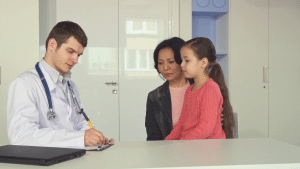A happy new year from everyone here at the UK Scoliosis Clinic!
If you’re a scoliosis sufferer or know someone who is, you might be looking for some impactful new year’s resolutions which can benefit scoliosis sufferers. With that in mind, here are some scoliosis friendly New Years resolutions which we recommend you take on!
Number one – Don’t wait and see!!
“Wait and see” or “observation” is the “old school” approach to scoliosis treatment. Observation simply means watching the scoliosis develop with the hope that it will not progress to the surgical threshold. Observation is therefore not a treatment, sadly observation almost always results in a negative outcome, since recent research has shown that scoliosis almost never resolves without treatment.[1] If you’re currently stuck with “wait and see” make this the year you take control!
Don’t just wait – Book a consultation with a scoliosis specialist! Observation once made sense, because it was thought that surgery was the only visible treatment option. Furthermore, it was also assumed that many cases of scoliosis would not process. Today was known that both are untrue – modern research has demonstrated, for example, that Juvenile scoliosis greater than 30 degrees increases rapidly and presents a 100% prognosis for surgery. Curves from 21 to 30 degrees are more difficult to predict but can frequently end up requiring surgery, or at least causing significant disability.[2]
On the positive side, the latest work on scoliosis has also shown that modern bracing technology allows for highly effective treatment, such that it has now been demonstrated that conservative treatment with a brace is highly effective in treating juvenile idiopathic scoliosis. In one recent study of 113 patients, the vast majority achieved a complete curve correction and only 4.9% of patients needed surgery.[3] As with all treatment, earlier action means better results so don’t wait! (or wait and see!)
Number two – Start screening your children
The gift of a scoliosis screening might be a life-changing one for your child. Two to three percent of adolescents between the age of 10 and 15 will develop scoliosis. That might seem like a small percentage, but in fact, it’s about one per class at school. Some studies have suggested a higher level, but two to three percent is an accepted figure. The risk is highest amongst girls and appears to be greater in individuals who participate in activities such as gymnastics.
If scoliosis is noticed in its very early stages, it is far easier to treat, so screening can make a real difference. What’s more, scoliosis screening is easy to do at home using our ScoliScreen tool. ScoliScreen was developed in Australia by our partner ScoliCare, who spent years researching and designing the easiest home screening tool available. Screening with ScoliScreen at home takes about 10 minutes – you don’t have to take any pictures or upload any information, just follow the steps on screen and note down your results. ScoliScreen isn’t an alternative to a professional consultation, but it’s a highly effective tool to use as a starting point.
Number Three- Find balance in your physical activities
Since asymmetrical strength and tension in the involved musculature is a common feature of scoliosis, it makes sense to try to avoid participating in activities which exaggerate this problem. That is to say since scoliosis often leads the muscles one side of the body to be stronger than the other, it makes sense to avoid making that worse with activities which build strength on one side of the body, but not the other. In fact, much of the work done with scoliosis specific exercise is aimed at correcting this imbalance.
Some practitioners suggest that activities which tend to asymmetrically load the body (most things with a bat or racket) should, therefore, be avoided – however, this approach is too broad in most cases and tends to cut off many of the most enjoyable sports!
The better solution is not to avoid these activities, but instead to carefully monitor growth and symmetry and perform targeted exercise on the non-playing side of the body (usually the non-dominant side) in order to balance out development. While this point is important to scoliosis patients, it’s actually good advice for anyone!
Once again, the best way to access professional monitoring and treatment is through a scoliosis specialist.
Number four – Raise awareness about scoliosis
Although scoliosis is a relatively common condition in young people (and actually a very common one in older people) scoliosis is also a mystery to many of us. This is partly because treatment options were limited for many years, but as we have shown this is not the case today.
In order to treat scoliosis more effectively and reduce the number of people eventually requiring surgery, most scoliosis clinicians now agree that school screening for scoliosis would be a positive step to take – for relatively little cost, significant benefits can be obtained for the majority of patients. Screening for scoliosis in schools and other groups, like classes or clubs is quick, easy and cheap. Using our ScolisScreen app, it’s also possible to pre-screen a friend or a family member at home in less than 10 minutes – but individual screening does little to raise awareness overall.
It’s no surprise that scoliosis screening is considered as a beneficial stage of treatment amongst the treatment community, and has been recommended by the Society on Scoliosis Orthopaedic and Rehabilitation Treatment (SOSORT). Despite this, school screening is still not provided in the UK, although it is now common in many other countries.
Because of the misplaced belief in limited treatment options which is common not only amongst the general population but also amongst GP’s – as well as the lack of screening programs, many cases go undetected and therefore progress.
Despite this, there’s much you can do to raise awareness about scoliosis – if you have friends or family with children – especially those between about 10 and 15 – send them the link to our ScoliScreen tool and let them know about screening. Be sure to let people know that today treatment is accessible and viable!
If you are active in a local school community, ask them about setting up a scoliosis screening program. The UK scoliosis clinic provides free school screening events for schools within a reasonable distance, and many other clinics will be happy to do the same.
Perhaps you’re involved in a larger community group or club – if you’re within a reasonable distance of our clinic get in touch and we’ll be happy to work with you on a group screening or awareness talk event.
[1] Progression risk of idiopathic juvenile scoliosis during pubertal growth, Charles YP, Daures JP, de Rosa V, Diméglio A. Spine 2006 Aug 1;31(17):1933-42
[2] Progression risk of idiopathic juvenile scoliosis during pubertal growth, Charles YP, Daures JP, de Rosa V, Diméglio A. Spine 2006 Aug 1;31(17):1933-42.
[3] ‘Brace treatment in juvenile idiopathic scoliosis: a prospective study in accordance with the SRS criteria for bracing studies – SOSORT award 2013 winner‘ Angelo G Aulisa, Vincenzo Guzzanti, Emanuele Marzetti,Marco Giordano, Francesco Falciglia and Lorenzo Aulisa, Scoliosis 2014 9:3 DOI: 10.1186/1748-7161-9-3




